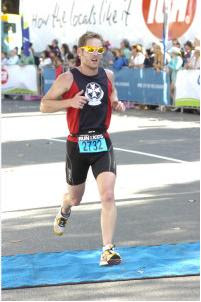R4TK Review

Let's attempt to find some answers. There were two key strategies that guided me for the 14.38km race:
- go out fast, build and hang on
- go fast, when the course is slow
I'll start with reference to the heart rate (HR) profile recorded and displayed below (click the image to link to a clearer one).
The first 35 seconds from the gun time, was occupied by moving very slowly towards the start line. The the first split marked is when I crossed the starting mat. From there I attempted to go out relatively quick for me, but was quite hampered by the number of competitors. The reality was I had a forced ease-into-it start. It wasn't until the decent into the tunnel where the gaps opened up and I could genuinely pick up speed. This is reflected with the steady increase in HR throughout the start. With hindsight, that first kilometer was definitely slower than I wanted. Maybe 20 seconds lost that I could have had with a clean run, but this is the reality of a race with big numbers. I'm still unsure exactly how this affects the rest of the race. Does the build allow a faster over all average time, or is simply some time I can't get back?
When the course turned more skyward, it is clear by the steeper rise in HR, I picked up the effort. Go fast when the course is slow. As the terrain leveled off, I settled into what still felt too fast. This took me through the first 5km at a 3:52/km pace. The next 5km was no trouble with competitor numbers. My effort was dictated by the terrain. The HR climbed on the uphill and settled back down a bit on the descents and flats. The average for this section was 3:47/km. The final 4.38km, I was struggling to keep the speed up, and while the HR was relatively constant, it was a little below that second 5km average. The slowing was steady over this last section, but the average here was 3:53/km.
As far as my HR curve shows, other than two key spikes on the main two climbs, followed by a small dip, the HR was fairly constant throughout. It remained right up above my anaerobic threshold level. Averaging 169bpm with peaks at 179bpm (90% & 95% of HRmax, respectively). So a reflection on a descent output. Looking at the HR curve, it would likely have been more efficient not to go quite so hard on the first climb, and ease off as much as I did just after this. A more even output over this first section may have gained me a few extra seconds overall.
- A steady build, without significant spikes in effort is likely to be an optimal race start
- There is still some room to push the average intensity up, such as from 90%HRmax to 95%.
- It should feel this hard. Suck it up and get used to it.
- Remember how the middle 5km felt. This is race pace.
- A lot can be gained or lost in the last 3rd.
- Running on feel can work, if you have a plan and know your body.




Comments
Post a Comment